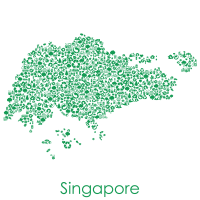1. Development
Singapore is a City-State that extends over an island territory of 735 square kilometers, with a population of 5.6 million inhabitants; it is an administrative territory slightly more than half the size of that of Rome Capital and with more than double the inhabitants. The GDP per capita is about 88,000 dollars, among the highest in the world and 2.6 times greater than the Italian one.
Originally a British colony, it joined the Federation of Malaysia in August 1963, but was expelled from it in 1965. On 9 August that year, the former colony officially became the Republic of Singapore, a member of the Commonwealth (of which it remains a member).
In 1967, Singapore co-founded ASEAN.
With the elections of May 30, 1965, Lee Kuan Yew was the first prime minister and held the post until 1990, later holding the post of “senior minister” during the premiership of his successor Goh. Choke Tong and since 2004, the year in which his eldest son , Lee Hsien, was appointed prime minister Loong , was a “mentor minister”, maintaining great political influence until his death in 2015. Lee Hsien Loong remained in office as prime minister until 15 May 2024, when he was replaced by Lawrence Wong , retaining the title of “senior minister”.
Singapore's government has a technocratic streak that has worked to develop the city-state into a thriving economy, one of the world's major financial capitals, with an industrial and service-based economy and one of the most efficient and advanced infrastructure systems in the world.
As of 2023, approximately 39% of Singaporeans are foreigners 1; in 2020, the population was 74.3% ethnic Chinese, 13.5% ethnic Malaysian, 9% ethnic Indian, and 3.2% a mix of other ethnicities 2.
The multi-ethnic and multi-religious composition of Singapore's population led to racial riots in the 1960s. The Singapore Government has since then worked to maintain a state of social harmony; in memory of the most serious riots of 1964, in 1997 the Singapore Government launched the " Racial Harmony Day ” 3, which is celebrated on July 21, however some particularly violent episodes in December 2013 indicate that, although under control, ethnic tensions are still present. In the same year, the government published the white paper “A sustainable population for a dynamic Singapore” 4, which predicted that by 2030, 50% of Singapore's population could be made up of immigrants from Central Asian areas, significantly reducing the weight of ethnic Chinese.
Nonetheless, Singapore remains one of the safest cities in the world, with 3,939 shoplifting incidents, 1,695 thefts, 1,528 harassment incidents and 476 cases of voyeurism.
Given its extremely small territory, Singapore is essentially devoid of natural resources, its economic system is based on the intelligent exploitation of its strategic logistical position, as a transit point for the routes connecting the Indian Ocean and East Asia and as a hub for the routes connecting insular Southeast Asia and Oceania.
Singapore has invested in an export-oriented manufacturing industry, which contributed 21.6% of GDP 5in 2023 (trade balance represents 37% of GDP) that relies on the import of raw materials and their processing, including petroleum refining and chemical production, chip, semiconductor and wafer manufacturing, biomedical manufacturing and mechanical manufacturing 6.
The wholesale trade and trading sector is the second largest contributor to GDP, with a share of 18.6%, followed by the finance and insurance sector, with a share of 13.5%, and the logistics sector, with a share of 10.4%.
Other significant sectors are professional and administrative services (8.4% of GDP), other service industries (9.3%), real estate and construction (5.6%) and information technology (5.4%).
In 2023, Small and Medium Enterprises represented 99% of the business fabric and employed 71% of the workforce, producing 44% of nominal Added Value.7
The city-state imports 90% of the food it consumes 8, to ensure food security, imports have been distributed across a plurality of supplier countries, 180 in 2022. In 2019, the Government launched the “30by30” goal, to produce 30% of the food needed by 2030, incentivizing technological and sustainable vertical production, such as hydroponic cultivation with recirculated water.
Water is a scarce resource, Singapore relies on the agreement with Malaysia, which will expire in 2061, to be able to import up to 1325 liters of water per day, but to ensure water security the Government has launched the "four taps" policy, which aims to invest in the reuse of purified water, desalination and the valorization of local reserves 9(5% of Singapore's territory is part of an aquatic context with two lakes and rivers).
Singapore is distinguished by its unique urban planning mechanism, in which the public housing agency (HDB – Housing & Development Board) plays a key role in the design and construction of individual buildings and entire residential villages 10, which in fact account for 77.8% of all housing in 2023. HDB-built homes can be purchased by residents, so much so that Singapore's ownership rate is one of the highest in the world: 89.7% of homes are owned by their residents 11.
To finance the decarbonisation of the economy, in 2019, Singapore launched the Carbon Tax , which in the period 2019 – 2023 was calculated at a fixed rate of 5 Singapore dollars (3.69 USD) per tonne of CO2 equivalent , then raised to 25 Singapore dollars (18.45 USD) in 2024 and will be progressively increased until it reaches between 50 and 80 Singapore dollars (36.89 – 59.03 USD) in 2030 12.
In February 2021, Singapore launched the “Singapore Green Plan 2030”, its strategy to advance the nation’s sustainable development agenda. The Green Plan 2030 sets out ambitious and concrete goals for the next 10 years, reinforcing Singapore’s commitments to the United Nations 2030 Agenda for Sustainable Development and the Paris Agreement, and setting a target of achieving carbon neutrality by 2050.
1https://www.reuters.com/world/asia-pacific/singapores-population-grows-5-foreign-workers-return-post-pandemic-2023-09-29
2https://www.singstat.gov.sg/-/media/files/publications/cop2020/sr1/findings.pdf
3https://www.nlb.gov.sg/main/article-detail?cmsuuid=d584f038-2d67-4a3b-b786-7d2116dbec3b
4https://www.strategygroup.gov.sg/images/publicationimages/chart7.png.pdf
5https://www.mas.gov.sg/-/media/mas-media-library/publications/recent-economic-developments/2024/recent-economic-developments-in-singapore-29-jan-2024.pdf
6https://www.edb.gov.sg/content/dam/edb-en/about-edb/media-releases/manufacturing-statistics/Census_of_Manufacturing_Activities/EDB%20Annual%20Mftg%20Performance%202022.pdf
7https://www.singstat.gov.sg/modules/infographics/economy#enterprise
8https://www.sfa.gov.sg/food-farming/sgfoodstory
9https://www.pub.gov.sg/Public/WaterLoop/OurWaterStory
10https://www.hdb.gov.sg/about-us/history/town-planning
11https://www.singstat.gov.sg/find-data/search-by-theme/households/households/latest-data
12https://www.nccs.gov.sg/singapores-climate-action/mitigation-efforts/carbontax/
